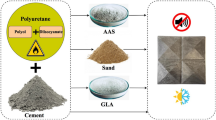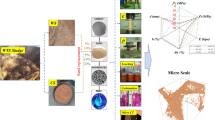Abstract
The environmental acceptability of geotechnical composites made of treated municipal sewage sludge (SwS) and paper ash (PA) after two different curing periods has been investigated. The mineral composition of such composites, including their content of major oxides, is mainly influenced by the PA. The content of potentially toxic elements (PTEs) in the initial materials and in the composites varies considerably. In the SwS the Ba, Cd, Cr, Cu, Hg, Ni and Zn contents are above the legally permitted limits. The PTE content of PA are lower, but still somewhat above the permitted values for Ba and Cu. Mixing these two materials together resulted in a decrease in the PTE, but the Ba, Cu and Zn contents are still too high for agricultural application. However, leachates from composites that had been cured for 28 days are highly alkaline, and the As, Ba, Cd, Cr, Hg, Mo, Ni, Pb and Zn contents in them are well below the permitted values. The Cu contents (2.4 to 5.4 mg/kg) are above the permitted limit for inert material, but inside the range for non-hazardous material. In a leachate of composite which was prepared with fresh PA and a lower PA to SwS ratio, the Cu content was 1.4 mg/kg, since fresh PA is more reactive and therefore has a higher ability to immobilise Cu. Therefore, such mixtures can be utilised for covers and liners for sanitary landfills.








Similar content being viewed by others
References
Ait-Benichou S, Cabral AR, Panarotto CT (2008) Evolution of biodegradation of deinking by-products used as alternative cover material. Waste Manag 28:85–96
Chiang KY, Chou PH, Hua CR, Chien KL, Cheesenan C (2009) Lightweight bricks manufactured from water treatment sludge and rice husks. J Hazard Mater 171:76–82
Demeyer A, Voundi Nkana JC, Verloo MG (2001) Characteristics of wood ash and influence on soil properties and nutrient uptake: an overview. Bioresour Technol 77:287–295
European Commissio (2015a) Closing the loop—an EU action plan for the Circular Economy, COM 614, final
European Commission (2014) Report on critical raw materials
European Commission (2015b) Communication from the commission, EUROPE 2020, A strategy for smart, sustainable and inclusive growth
European Waste Catalogue and Hazardous Waste List (2002) Environmental Protection Agency.
Eurostat (2015) Available from http://epp.eurostat.ec.europa.eu Accessed 7 June 2016
Frossard E, Bauer JP, Lothe F (1997) Evidence of vivianite in FeSO4-flocculated sludges. Water Res 31:2449–2454
Guideleine for Recycled Construction Materials (2009) 8th Edition; Austrian Construction Materials Association, Wien. http://www.contaminatedland.co.uk/std-guid/dutch-l.htm#KEYWORD-LINKS Accessed 7 June 2016
Kabbe C (2013) Challenges for P recovery and recycling from sewage sludge in Europe. END-O-SLUDG Conference, Brussels, 11. 12. 2013
Karltun E, Saarsalmi A, Ingerslev M, Mandrea M, Anderssonl S, Gaitniekss T, Ozolindius R, Varnagiryte-Kabasinskiene I (2008) Wood ash recycling—possibilities and risks. In: Röser D et al (eds) Sustainable use of forest biomass for energy: a synthesis with focus on the Baltic and Nordic Region. Springer Science Business Media B.V, Heidelberg, pp. 79–108
Kumpiene J, Lagerkvist A, Maurice C (2008) Stabilization of As, Cr, Cu, Pb and Zn in soil using amendments—a review. Waste Manag 28:215–225
Latare AM, Kumar O, Singh SK, Gupta A (2014) Direct and residual effect of sewage sludge on yield, heavy metals content and soil fertility under rice–wheat system. Ecol Eng 69:17–24
Leonard A (2011) Management of wastewater sludge’s: a hot topic at the European level. Journal of Residuals Science and Technology 8:38
Liu J, Sun S (2013) Total concentrations and different fractions of heavy metals in sewage sludge from Guangzhou, China. Trans Nonferrous Metals Soc China 23:397–2407
Milleu Ltd., WRc and Risk & Policy Analysts Ltd. (RPA) (2010) Environmental, economic and social impacts of the use of sewage sludge on land. Final Report, Part III: Project Interim Reports, 116
Official Gazette of the Republic of Slovenia No. 68/96 (1996) The regulation on limit, the action and critical emission levels of dangerous substances in the soil. Ljubljana, 5773–5774 (in Slovenian)
Official Gazette of the Republic of Slovenia No. 61/11 (2011) Decree on waste landfill. Ljubljana, 8857–8876 (in Slovenian)
Pavšič P, Mladenovič A, Mauko A, Kramar S, Dolenec M, Vončina E, Pavšič Vrtač K, Bukovec P (2014) Sewage sludge/biomass ash based products for sustainable construction. J Clean Prod 67:117–124
Ščančar J, Milačič RU, Stražar M, Burica O (2000) Total metal concentrations and partitioning of Cd, Cr, Cu, Fe, Ni and Zn in sewage sludge. Sci Total Environ 250:9–19
Shi W, Liu C, Ding D, Lei Z, Yang Y, Feng C, Zhang Z (2013) Immobilization of heavy metals in sewage sludge by using subcritical water technology. Bioresour Technol 137:18–24
SIST EN 1097-5 (2008) Tests for mechanical and physical properties of aggregates—part 5: determination of the water content by drying in a ventilated oven
SIST EN 1097-6 (2013) Tests for mechanical and physical properties of aggregates—part 6: determination of particle density and water absorption
SIST EN 13286-2:2010/AC (2013) Unbound and hydraulically bound mixtures—part 2: test methods for laboratory reference density and water content—Proctor compaction
SIST EN 1744-3 (2002) Tests for chemical properties of aggregates—part 3: preparation of eluates by leaching of aggregates
SIST EN 196-1 (2005) Methods of testing cement—part 1: determination of strength
SIST EN ISO 10304-1:2009/AC (2012) Water quality—determination of dissolved anions by liquid chromatography of ions—part 1: determination of bromide, chloride, fluoride, nitrate, nitrite, phosphate and sulfate—Technical Corrigendum 1 (ISO 10304-1:2007/Cor. 1:2010).
SIST EN ISO 12846 (2012) Water quality—determination of mercury—method using atomic absorption spectrometry (AAS) with and without enrichment
SIST EN ISO 17294-2 (2005) Water quality—application of inductively coupled plasma mass spectrometry (ICP-MS)—part 2: determination of 62 elements
Sloot HA vander Heasman L, Quevauviller PH (Eds.) (1997) Harmonisation of leaching extraction tests. Studies in Environmental Science 70, Elsevier Science, 292
Smith SR (2009) A critical review of the bioavailability and impacts of heavy metals in municipal solid waste composts compared to sewage sludge. Environ Int 35:142–156
Song F, Gu L, Zhu N, Yuan H (2013) Leaching behavior of heavy metals from sewage sludge solidified by cement-based binders. Chemosphere 92:344–350
Thy P, Jenkins BM, Grundvig S, Shiraki R, Lesher CE (2006) High temperature elemental losses and mineralogical changes in common biomass ashes. Fuel 85:783–795
Torri SI (2009) Feasibility of using a mixture of sewage sludge and incinerated sewage sludge as a soil amendment. In: Baily RE (ed) Sludge: types, treatment, processes and disposal. Nova Science Publishers Inc., New York, pp. 185–208
Tuan BLA, Hwang CL, Lin KL, Chen YY, Young MP (2013) Development of lightweight aggregate from sewage sludge and waste glass powder for concrete. Constr Build Mater 47:334–339
Vale P (2013) Phosphorus recovery from wastewater END-O-SLUDG conference sludge and phosphorus management in Europe: present and future London:3.12.2013
Valls S, Yague A, Vazquez EA, Mariscal C (2012) Physical and mechanical properties of concrete with added dry sludge from a sewage treatment plant. Cem Concr Res 34:2203–2208
Wong JWC, Selvam A (2006) Speciation of heavy metals during co-composting of sewage sludge with lime. Chemosphere 63:980–986
Yusiharni E, Gilkes R (2012) Minerals in the ash of Australian native plants. Geoderma 189:369–380
Zhen G, Zhou H, Zhao T, Zhao Y (2012) Performance appraisal of controlled low-strength material using sewage sludge and refuse incineration, bottom ash. Chin J Chem Eng 20:80–88
Acknowledgments
The authors gratefully acknowledge the support of the Ministry of Higher Education, Science, and Technology of the Republic of Slovenia (Programme P1-0008 and P2-0273).
Author information
Authors and Affiliations
Corresponding authors
Additional information
Responsible editor: Philippe Garrigues
Rights and permissions
About this article
Cite this article
Mladenovič, A., Hamler, S. & Zupančič, N. Environmental characterisation of sewage sludge/paper ash-based composites in relation to their possible use in civil engineering. Environ Sci Pollut Res 24, 1030–1041 (2017). https://doi.org/10.1007/s11356-016-7843-2
Received:
Accepted:
Published:
Issue Date:
DOI: https://doi.org/10.1007/s11356-016-7843-2




